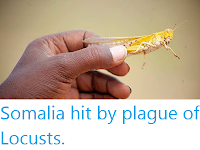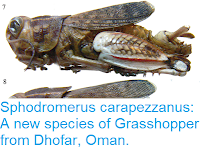Swarms of Desert Locusts, Schistocerca gregaria, that have been troubling Pakistan since November have began to move across the border into neighbouring areas of Gujarat and Rajastan states, India, this week, threatening crops in the region. Farmers in the area are reported to be battling the Insects on their own, by burning tyres and banging pots and drums, while complaining that little support is being received from central government, despite ample warnings having been given by Pakistan.
Locusts attacking crops in Gujarat State, India, this week. Go News India.
Desert Locusts typically have two or three generations in a year, but when conditions are favourable then five or more generations can occur. The females lay eggs in an ootheca (egg sack) in soft sand, where they can remain dormant until conditions are favourable or hatch within a few days. Hatchlings can reach maturity in about five weeks, eating as much as one-and-a-half times their body weight each day, when they are potentially able to breed again.
The adult form of the Desert Locust has two forms, the more usual solitary form, which does not usually move far from the area where they emerge, and a gregarious form, which forms large swarms and can roam long distances. The change from solitary to gregarious Locusts can happen in individuals, which change from one to the other in response to a rise in population density, but the reverse, a change from gregarious to solitary Locusts, can only happen when a new generation reaches maturity.
Solitary (top) and gregarious (bottom) Desert Locust nymphs. Compton Tucker/NASA/Goddard Space Flight Center/Wikimedia Commons.
See also...
Follow Sciency Thoughts on Facebook.








